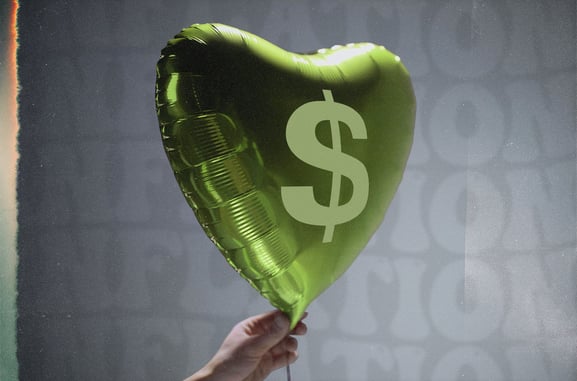
Latest Article: What is a Sovereign Wealth Fund and Why is America Creating One?
What is Inflation? How it's Created and Why it Matters
Learn about what inflation is, how inflation is created, and how inflation is calculated. Understand the role the Federal Reserve plays in inflation.
INVESTINGBUSINESSACCOUNTINGECONOMY
David Kindness, CPA
8/17/2024



What is Inflation? How it's Created and Why it Matters
Published on August 16, 2024
Written by David Kindness, CPA
Why you can trust Your Creative CPA
Our content is written, edited, or both by industry experts who are creative entrepreneurs just like you. Learn more.
Inflation is a term you've likely heard in the news, but understanding exactly what it means can be confusing. Is it an increase in the prices of goods and services over time? Is it an increase in the number of dollars in circulation? Either way, the result of inflation is that your dollar today won't buy as much as it did yesterday.
In this article, we'll explain what inflation is, what (or who) creates it, and how it impacts the economy - in more ways than you might think. Learn about how inflation is an invisible tax, how it can change the GDP overnight (or can it?), and how it's influenced by the most powerful entities on earth.
Fast Facts About Inflation
Inflation is the increase in prices of goods and services over time, caused by the increasing volume of currency in circulation.
The lower the inflation rate, the better.
High inflation can erode purchasing power and make it more expensive to live.
The opposite of inflation is deflation: a decrease in the money supply due to removing currency from circulation.
What is Inflation?
There are actually two different definitions of inflation: the technically correct definition and the popularized definition. The technically correct definition is that inflation is the increase in the volume of currency in circulation, which means more dollar bills are being created. The popularized definition is that inflation is the gradual increase in the price of goods and services in an economy.
Under either definition, inflation means that you'll pay more for things like groceries, gas, and rent. Inflation is measured by calculating the percentage change in the Consumer Price Index (CPI), which is the amount it costs in US dollars (USD) to purchase a basket of goods and services, like a gallon of gas, an apple or banana, a head of lettuce, an ounce of steak, etc.
While both definitions of inflation are important, we'll be focusing on the lesser-known (but far more interesting) technical definition of inflation.
What Causes Inflation?
Now that we understand what inflation is, the most important interesting question is what causes it. We're about to get a little bit technical, but trust me: the concept is easier than it seems. Inflation is caused by increasing the number of dollars in circulation. The number of dollars can increase in two different ways...
The first way that the volume of currency increases is when the Federal Reserve prints money
Let's start by describing what the Federal Reserve is. The Federal Reserve is a group of large banks that got together in 1913 to manage the printing and distribution of US dollars. The current Federal Reserve is the fourth in our nation's history, with the previous three failing for one reason or another. Despite its name, the Federal Reserve is not part of the United States federal government - instead, it is an independent entity that effectively loans US Dollars (USD) to the federal government by purchasing government bonds, which are a form of debt.
Back when it was created, the Federal Reserve literally printed US dollars using a large, complex printing machine. Today, the Federal Reserve "prints" dollars by making simple accounting entries (for the accounting nerds amongst us, they do this by debiting cash and crediting equity) the artificially increase numbers on a screen.
Because the Federal Reserve is a group of non-governmental banks, the United States is one of the only countries on earth where the printing and distribution of currency is controlled by a non-governmental entity. This means that the Federal Reserve controls both the money supply, and as a result, the control the majority of the inflation that affects the US dollar. And because the US Dollar is the world's reserve currency, many other countries are also affected by the Federal Reserve's decisions.
The second way that the volume of currency increases is when banks loan a multiple on their reserves
The volume of currency can also increase when banks loan a multiple on their cash reserves. For example, if a bank has $10 billion in cash reserves (generally from customer deposits) they could loan 10 times that amount, or $100 billion, to bank customers for things like mortgages, business loans, lines of credit, etc. This means that the bank has increased the volume of dollars by $90 billion dollars, which increases inflation for everyone.
Fast Fact: part of the reason that the Federal Reserve was created was to ensure that US banks keep the same percentage of cash reserves on hand at all times (for example, 10%). Not only does this make loans between banks less risky, but it also helps to ensure that when people want to withdraw money from the bank, the bank has enough cash to support those withdrawals.
Just like how a balloon inflates as the volume of air inside it increases, a currency inflates as the volume of currency in the market increases - whether that's from the fed printing money, or from banks loaning more than they have.
Just like how a balloon inflates as the volume of air inside it increases, a currency inflates as the volume of currency in the market increases.

How does Inflation Affect the Economy?
Inflation affects the economy in a few different ways, outside of the impact it has on the value of currency. One of the significant effects of inflation is that it artificially inflates economic growth, which can be used by politicians or bankers to influence people's perception of how well the economy is doing. Let's start by explaining the difference between real economic growth and artificial economic growth:
Real economic growth is created by businesses increasing production and sales, lowering costs and increasing profits, increasing stock prices, and more. All of these elements increase a country's Gross Domestic Product (GDP), which is the total economic value that a country produces, measured in that country's currency.
Artificial economic growth is caused by inflation. Because inflation increases the amount of currency in a country's economy and goods and services will cost more dollars to purchase, this will result in the country's GDP increasing by the amount of inflation. If inflation is 3%, the country's economic growth will appear to increase by 3%, even though this is only an artificial increase and not real economic growth.
Both real and artificial economic growth can look like real economic growth - even though they are not - if we don't know the difference between the two. For example, if the government says that inflation is 3% and the economy is growing by 2%, that equals 5% in perceived economic growth (3% + 2% = 5%). But if inflation is actually 6% and real growth is actually -1% (so the economy is shrinking), then the perceived economic growth is still 5% (6% - 1% = 5%), even though real growth is actually negative.
Politicians and bankers use these two metrics to impact people's perception of economic growth in order to influence elections, trust in the financial sector, and public sentiment about banks and politicians.
Is Inflation a Form of Tax?
Inflation is essentially a form of taxation. This is because inflation transfers economic value from citizens to the Federal Reserve (or from any country's citizens to that country's central bank). Whenever the Federal Reserve prints money, they increase the quantity of their dollars, while everyone else has the same quantity of dollars. As a result, inflation causes the value of all dollars to decrease (because there are more of them), but because the Federal Reserve has proportionally more dollars, their economic value increases as everyone else's economic value shrinks.
This is in contrast to regular taxes (like income taxes or capital gains taxes), where citizens actively transfer dollars to the government rather than inactively transferring economic value to the Federal Reserve. Both inflation and taxation are types of taxes - one is a dollar tax, and the other is a value tax.
Annual Inflation Rates
Inflation rates fluctuate over time based on several factors, including the rate of the Federal Reserve's money printing, the multiple on cash reserves being loaned by banks, and the sale or repurchase of government bonds (debt instruments) by the federal government. Central banks often target a specific inflation rate, such as 2% or 4%, to maintain price stability, but the inflation rate changes frequently, and how inflation is calculated can have a large impact on the inflation rate - which we'll discuss in the next section.
According to the US Labor Department, the inflation rate for the previous several years are as follows:
The 2024 inflation rate, as of August, is 2.9%.
The 2023 inflation rate was 3.4%.
The 2022 inflation rate was 6.5%.
The 2021 inflation rate was 7%.
The 2020 inflation rate was 1.4%.
The 2020 inflation rate was 2.3%.
The 2020 inflation rate was 1.9%.
The 2020 inflation rate was 2.1%
However, the actual inflation rate may differ from these amounts due to changes in the formula for calculating inflation since the mid-1900s. Keep in mind that the group of politicians and bankers currently in power are incentivized to make inflation seem as low as possible. Inflation can be lowered by simply changing the formula for calculating it. We'll discuss this issue more in the future, either in an update to this article or in another separate article - stay tuned.
How is Inflation Calculated?
Inflation is typically measured using a price index, such as the Consumer Price Index (CPI). This index tracks the average price changes of a "basket of goods and services" over time. A basket of goods and services is basically just a bunch of everyday items, like a gallon of gas, food at the grocery store, and utilities at home. By comparing the CPI from one period to another, for example by dividing the current-year CPI by the previous-year CPI, economists can calculate the inflation rate.
What is The Current Inflation Rate?
The current inflation rate varies by currency and by country. You can find the latest inflation data for your country on their government website, or through financial news outlets. According to the US Labor Department, the 2024 inflation rate is 2.9% as of August 2024, although estimates of actual inflation by financial experts vary significantly, with some reaching a staggering 9% or higher.
How to Fight Inflation While Staying Creative
While you can't control inflation, you can take steps to protect your business. Here's how to combat inflation while staying creative:
Monitor prices: keep track of the prices of your inputs and outputs to identify cost increases early on.
Increase prices: if possible, adjust your prices to reflect increased costs without pricing yourself out of the market.
Improve efficiency: find ways to reduce costs and increase productivity to maintain profitability.
Diversify income streams: explore additional revenue sources to offset the impact of inflation.
Invest excess funds: if you have extra funds lying around, consider investing them in the stock market - we love mutual funds and ETFs - to earn interest and dividends, and offset inflation.
By understanding inflation and taking proactive measures, you can better navigate economic challenges and protect your business's bottom line.
Frequently Asked Questions (FAQs)
What is deflation?
Deflation is the opposite of inflation: it's a reduction in the amount of currency in circulation. This can be achieved by selling government bonds to citizens, which they pay cash for and which removes cash from circulation. Banks can also increase interest rates, which is the amount of interest charged on loans made from one bank to another, which slows down borrowing and reduces cash outflows into the economy.
How does inflation affect the stock market?
Inflation can impact the stock market in various ways. Generally, high inflation tends to negatively affect stock prices as it increases the cost of doing business and reduces profit margins for companies. It can also increase uncertainty for businesses, because they may not be able to alter their prices quickly or frequently enough to reflect changes in their costs caused by inflation.
How does inflation affect interest rates?
Central banks, like the Federal Reserve, often raise interest rates to combat inflation. By making borrowing more expensive, it can slow down economic activity and reduce demand, which can help to curb inflation.
What does it mean when the Federal Reserve increases or decreases interest rates?
Banks loan money to each other all the time. Anytime a bank loans money to anyone - including to other banks - they charge an interest rate on that loan. One reason the Federal Reserve was created was to ensure that banks don't charge each other excessively high interest rates. As a result, when the Federal Reserve sets an interest rate, that's the rate that banks charge when they loan each other money. Then, if a consumer takes out a loan from a bank, the bank charges them the Federal Reserve's interest rate plus extra, in order to make money.
How does inflation affect the value of the dollar?
Inflation erodes the purchasing power of the dollar, meaning it takes more dollars to buy the same goods and services over time. This can lead to a decrease in the dollar's value compared to other currencies.
What is hyperinflation?
Hyperinflation is rapid, uncontrolled inflation that can devastate an economy. It occurs when money loses its value at a rapid pace, leading to economic instability. Often, this happens when a currency is abandoned by much of the world, thus driving down its value, or when an economy begins to collapse, resulting in the printing of too much currency.
Disclaimer: the information provided in this article is for educational purposes only and does not constitute tax, accounting, investing, legal, or financial advice. The information in this article does not take into account your unique financial or business situation or goals, and YCCPA cannot be responsible for reader's financial decision-making. YCCPA's goal is to educate and support you on your creative business journey.
Written by David Kindness, CPA
David is a CPA (Certified Public Accountant) and professional photographer, videographer, and designer based in San Diego, California. Learn more.




supported by ads
Your Creative CPA is supported by the ads you see in our articles and guides.
These ads help us help creatives like you.

financial wisdom for creatives, by creatives
Created by David Kindness
Copyright 2025 Terms






